Tobacco and vaping framework: roadmap to 2034
This focuses on both tobacco and vaping and sets our direction to 2034. It also includes the first implementation plan, which will run until November 2025.
4. Roadmap to 2034
Work began in January 2022 to develop a new action plan. This was developed through engagement with a working group of public health experts. This included ASH Scotland, Public Health Scotland, Cessation coordinators, academics and The Society of Chief Officers of Trading Standards in Scotland (SCOTSS).
This initial development work also included reviewing the recommendations from Javed Khan's Independent Review of Tobacco Control and world-leading international approaches being considered elsewhere such as New Zealand's Smokefree Aotearoa 2025 Action Plan[26].
Engagement also included views from the Poverty Alliance Scotland and from the 11th Citizen Panel for Health[27].
This engagement was critical in developing and shaping the content of the next plan.
A range of key recommendations came out of this process for the development of the next phase of our tobacco control policy in Scotland:
- a new plan must be responsive to the rapidly changing landscape, especially around the rise in popularity of vapes;
- it should have a focus on both tobacco and vaping;
- it should be adaptable enough that does not need to be refreshed every 5-years;
- it should have well defined measures of success;
- it should be underpinned by targeted actions;
- it should have clear and transparent accountability; and
- it must meet the 5% 2034 target across Scotland, including at SIMD 1 and 2.
Building on this engagement we are taking a different approach for this phase for Scotland's tobacco control policy.
We present here our overarching Framework, which will focus on both tobacco and vaping, with actions underpinned by a series of shorter action-focused 2-year implementation periods. This will allow for flexibility within the Framework, developing and adapting actions to react to an ever-evolving policy area, and ongoing tobacco, nicotine and vaping product development.
At the heart of the Framework is our renewed commitment to the 2034 tobacco-free generation that was set in 2013. This is the cornerstone of the work of the Framework.
The Tobacco and Vaping Framework is summarised in Figure 4.
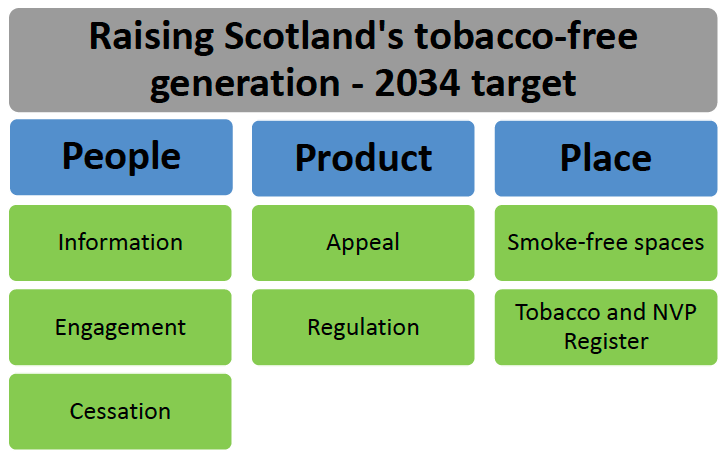
There are three overarching themes:
- People – What we can do to prevent uptake and what support we can provide to help people stop smoking, and to educate them on the risks;
- Product – What restrictions and limitations can be placed on tobacco containing products to further reduce use and ensure NVPs are used appropriately to support cessation but deter take up where not used for quitting tobacco; and
- Place – What restrictions and limitations can be placed on how and where tobacco and NVPs products are sold to deter use of the former and ensure appropriate use of the latter.
These will be supported by three principles:
- Transparency – Adherence and promotion of the principles of the WHO FCTC guidelines and specifically article 5.3;
- Sustainability – Continued funding to support the Framework and actions within it; and
- Accountability – Good governance of the implementation of the framework and progress towards the 2034 target.
It is important that the Framework continues to reduce the impact of health inequalities and this will underpin our approach.
Where required Impact Assessments and Business Regulatory Impact Assessments will be published to support the justification for action.
4.1 Tracking progress
It is important that we have a baseline from which to track and report progress towards our 2034 target. There are five key indicators that will be annually reviewed to monitor progress.
These will then be supplemented by further indicators that will be developed within the first implementation plan of the framework (see section 5).
Indicator one: adult smoking prevalence in Scotland
Smoking rates have declined steadily since 2008 (Figure 5), with 11% of adults identifying as current smokers[28] in 2021.
- 12% Men
- 11% Women
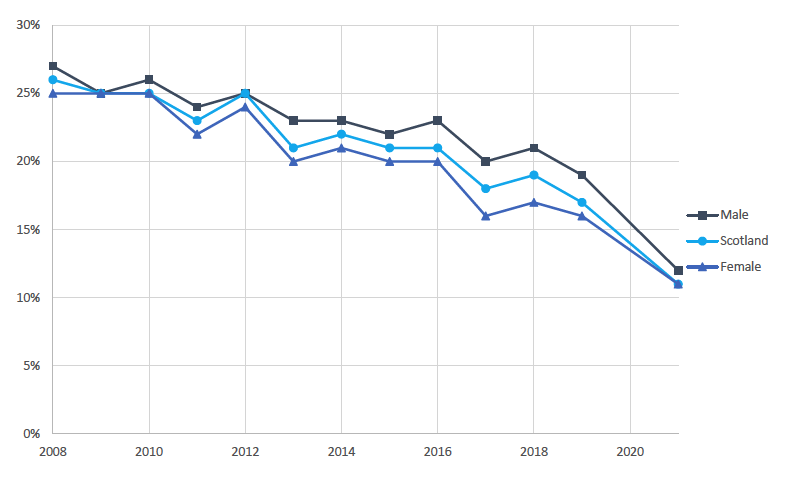
Key Source: Scottish Health Survey
Key indicator two: adult smoking prevalence by deprivation[29]
As in previous years, adults living in the most deprived areas in 2021 were more likely to be current cigarette smokers (Figure 6).
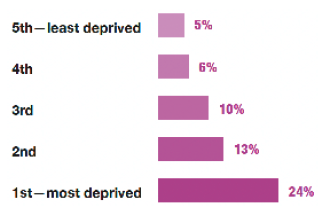
Although rates of smoking remain high in areas of deprivation there has been a reduction in the gap between most and least deprived since 2008 from 24% gap in 2008 to 19% gap in latest data in 2021 (Figure 7).
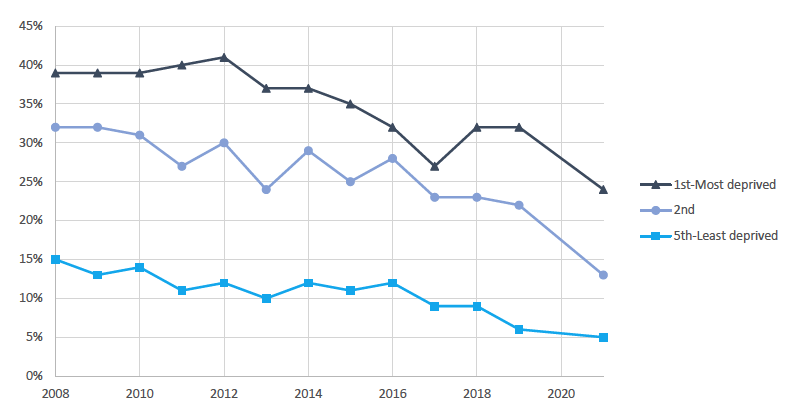
Key Source: Scottish Health Survey
Key indicator three: maternal smoking at first antenatal appointment
In 2022, there were 5,913 pregnancies booked for maternity care where women reported smoking (11.9%).[30]
The percentage of pregnancies where women reported smoking was nine times higher for those living in the most deprived areas compared to least deprived areas.
The proportion of women reporting being current smokers at booking has declined from 31% in 1997/98 (Figure 8).[31]
Although rates of smoking remain high in areas of deprivation there has been a reduction in the gap between most and least deprived from 39.5% gap in 1997/98 to 20% gap in latest data in 2021/22.
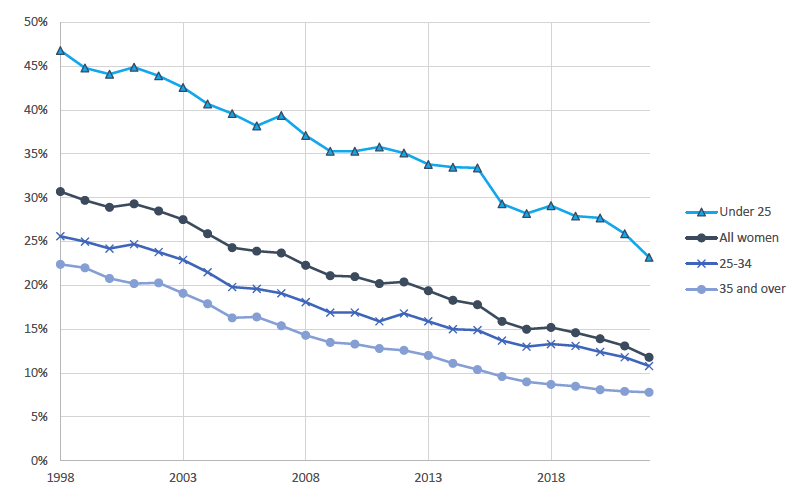
Key Source - Public Health Scotland – Antenatal booking in Scotland
Key indicator four: (i) smoking and (ii) vaping behaviour in children and young people
Health Behaviour in School-Aged Children 2022 (HBSC) (Scotland)[32] reports that 3% of 13-year-olds, and 11% of 15-year-olds have smoked a cigarette in the past 30 days (Figure 9).
HBSC 2022 also reports that 5% young people said they currently smoked cigarettes and this increased with age. This has declined from 30% in 1998. Lifetime cigarette smoking is at its lowest level in 32 years.
Three percent of 11-year-olds, 10% of 13-year-olds and 25% of 15-year-olds said they had used an e-cigarette in the past 30 days. HBSC 2022 also reports that 3% of 11-year-olds, 12% of 13-year-old boys and 19% of 13-year-old girls and 33% of 15-year-old boys and 40% of 15-year-old girls have ever used an e-cigarette.
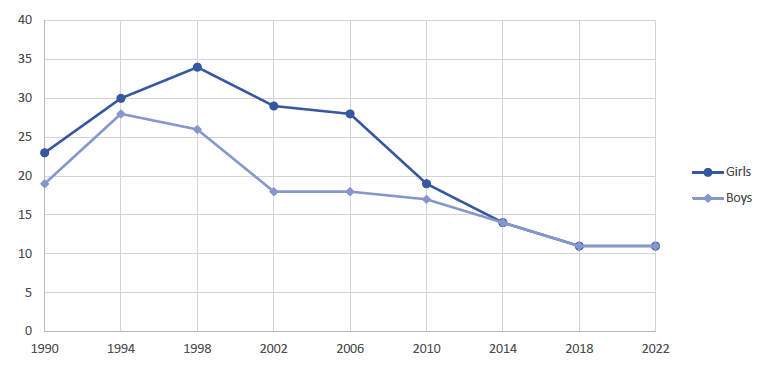
Key Source: Health Behaviour in School-Aged Children[33]
Indicators are summarised in Table 1.
Indicator |
Description |
Coverage |
Source |
Reporting frequency |
|---|---|---|---|---|
1 |
Adult current smoking status |
Scotland - gender |
Scottish Health Survey |
Annual |
2 |
Adult current smoking status |
Scotland - deprivation |
Scottish Health Survey |
Annual |
3 |
Adult maternal smoking status |
Scotland – deprivation |
Public Health Scotland – Antenatal Booking in Scotland |
Annual |
4i |
Childhood smoking |
Scotland, 11, 13 and 15 year-olds |
Health Behaviour in School-Aged Children[34] |
Every 4-years |
4ii |
Childhood vaping |
Scotland, 13 and 15 year-olds |
Health Behaviour in School-Aged Children |
Every 4-years |
4.2 Developing actions
As noted earlier, unlike previous tobacco plans Scottish Government is taking a more responsive approach, departing from 5-year reviewed action plans, instead setting an overarching Tobacco and Vaping Framework with actions being underpinned by shorter action-focused 2-year implementation periods.
This approach will allow for flexibility within the Framework, developing and adapting actions to react to an ever-evolving area, and ongoing tobacco, nicotine and vaping product development.
This will also allow for more regular review of progress and more frequent setting of actions that can target areas of intervention to ensure we achieve our 2034 target.
At the end of each successive implementation plan a progress report will be published and a new implementation released. This is shown in Table 2.
2023 |
2025 |
2027 |
2029 |
2031 |
2034 |
|---|---|---|---|---|---|
Framework published |
|||||
First Implementation plan published |
First Implementation Plan Report |
||||
Second Implementation Plan published |
Second Implementation Plan Report |
||||
Third Implementation Plan published |
Third Implementation Plan Report |
||||
Fourth Implementation Plan Published |
Fourth Implementation Plan Report |
||||
Final 2034 Implementation Plan |
Final 2034 report on Framework |
||||
Publication of beyond 2034 plan |
|||||
Core prevalence indicators baseline published |
Annual progress report on core prevalence indicators using latest available data |
||||
New indicators published |
Regular indicator report on additional indicators |
||||
Contact
Email: Tobaccocontrolteam@gov.scot
There is a problem
Thanks for your feedback